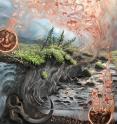Carbon dioxide biggest player in thawing permafrost
Carbon dioxide emissions from dry and oxygen-rich environments will likely strengthen the climate forcing impact of thawing permafrost on top of methane release from oxygen-poor wetlands in the Arctic, according to a study in Nature Climate Change led by Northern Arizona University assistant research professor Christina Schädel. Schädel's meta-analysis of 25 Arctic soil incubation studies found that both temperature and soil conditions affected the quantity of carbon released from thawing permafrost. A 10 °C increase in soil temperature released twice as much carbon into the atmosphere, and drier, aerobic soil conditions released more than three times more carbon than wetter, anaerobic soil conditions.
Most of that carbon was in the form of carbon dioxide, mixed with a surprisingly small amount of methane--only 5 percent of the total anaerobic products. This means that even though methane packs 34 times the climate warming punch of carbon dioxide, the small quantity released relative to carbon dioxide in anaerobic conditions makes wet soils less of a concern than dry soils.
"Our results show that increasing temperatures have a large effect on carbon release from permafrost but that changes in soil moisture conditions have an even greater effect," says Schädel. "We conclude that the permafrost carbon feedback will be stronger when a larger percentage of the permafrost zone undergoes thaw in a dry and oxygen-rich environment. "
Scientists in the international Permafrost Carbon Network that Schädel co-leads with Northern Arizona University professor of ecosystem ecology, Ted Schuur, provided much of the data.
As the permafrost thaws, microbes wake up and begin digesting the newly available remains of ancient plants and animals stored as carbon in the soil. This digestion produces either carbon dioxide or methane, depending on soil conditions. Scientists want to understand the ratio of carbon dioxide to methane gas released by this process because it affects the strength of the permafrost carbon feedback loop: greenhouse gases released due to thawing permafrost cause temperatures to rise, leading to even more thawing and carbon release. Furthermore, the Arctic permafrost is like a vast underground storage tank of carbon, holding almost twice as much as the atmosphere. At that scale, small changes in how the carbon is released will have big effects.
Schädel zeroed in on two factors: soil temperature and the availability of oxygen. Soils in the lab were incubated at a range of warmer temperatures projected for the future. The availability of oxygen is important because it determines how microbes digest carbon. Oxygen-rich, or aerobic, conditions are found in dry soils and produce carbon dioxide. Oxygen-poor, or anaerobic, conditions are found in wet soils and produce both carbon dioxide and methane. Lab incubations mimicked these two conditions.
Will wet or dry soils dominate the future Arctic permafrost zone? The answer to this question is a big unknown. Schädel's work, however, will strengthen existing models of the permafrost ecosystem. Her work also highlights the need to monitor changes in wetness associated with permafrost thaw, changes that ultimately sculpt the topography of waterlogged depressions and dry uplands across the Arctic landscape.
Source: Northern Arizona University
Articles on the same topic
- Permafrost thawing below shallow Arctic lakesThu, 16 Jun 2016, 16:56:14 UTC
- Drying Arctic soils could accelerate greenhouse gas emissionsMon, 13 Jun 2016, 20:03:27 UTC
- Carbon dioxide biggest player in thawing permafrostMon, 13 Jun 2016, 19:37:36 UTC
Other sources
- Permafrost thawing below shallow Arctic lakesfrom Science DailyFri, 17 Jun 2016, 1:21:02 UTC
- Permafrost thawing below shallow Arctic lakesfrom PhysorgThu, 16 Jun 2016, 17:31:02 UTC
- Drying Arctic soils could accelerate greenhouse gas emissionsfrom Science DailyTue, 14 Jun 2016, 3:01:07 UTC
- Drying Arctic Soils Could Accelerate Greenhouse Gas Emissionsfrom Newswise - ScinewsMon, 13 Jun 2016, 20:30:58 UTC
- Carbon Dioxide Biggest Player in Thawing Permafrostfrom Newswise - ScinewsMon, 13 Jun 2016, 19:30:57 UTC
- Carbon Dioxide Biggest Player in Thawing Permafrostfrom Newswise - ScinewsMon, 13 Jun 2016, 18:31:06 UTC
- Carbon dioxide biggest player in thawing permafrostfrom Science DailyMon, 13 Jun 2016, 18:01:36 UTC
- Carbon dioxide biggest player in thawing permafrostfrom PhysorgMon, 13 Jun 2016, 15:01:06 UTC
